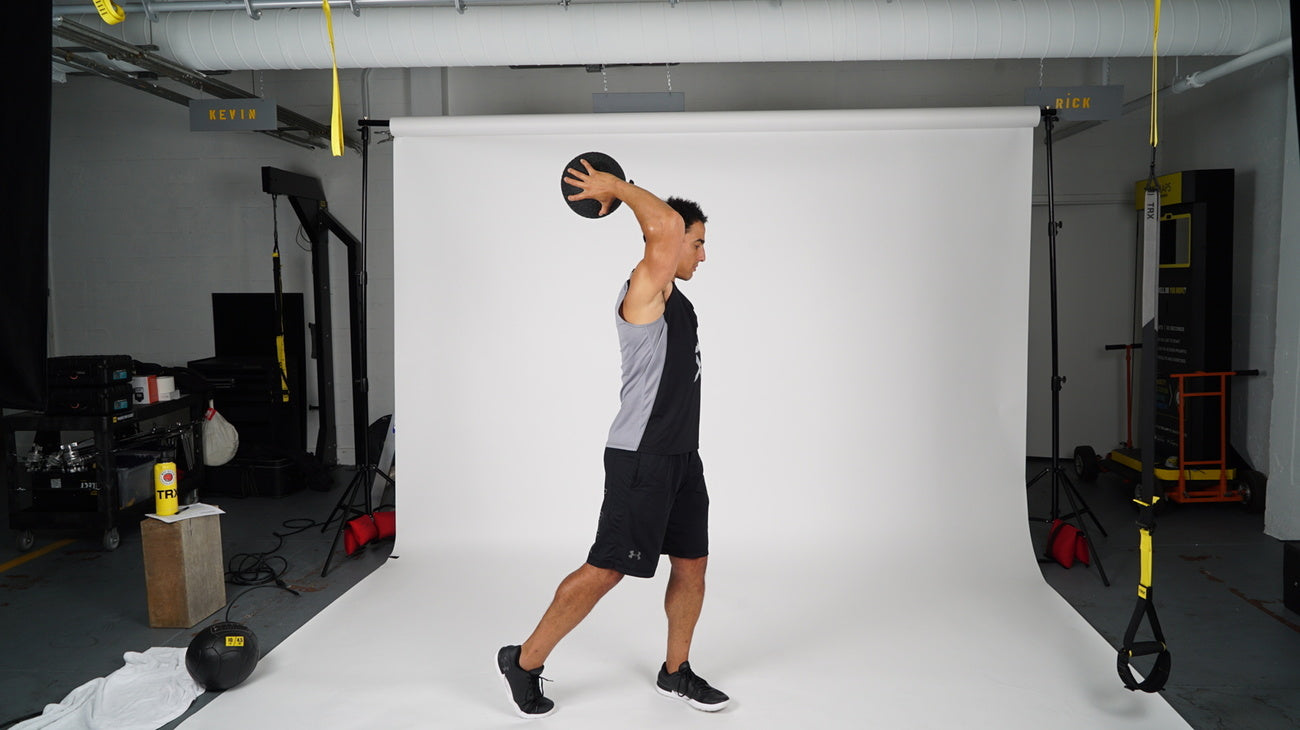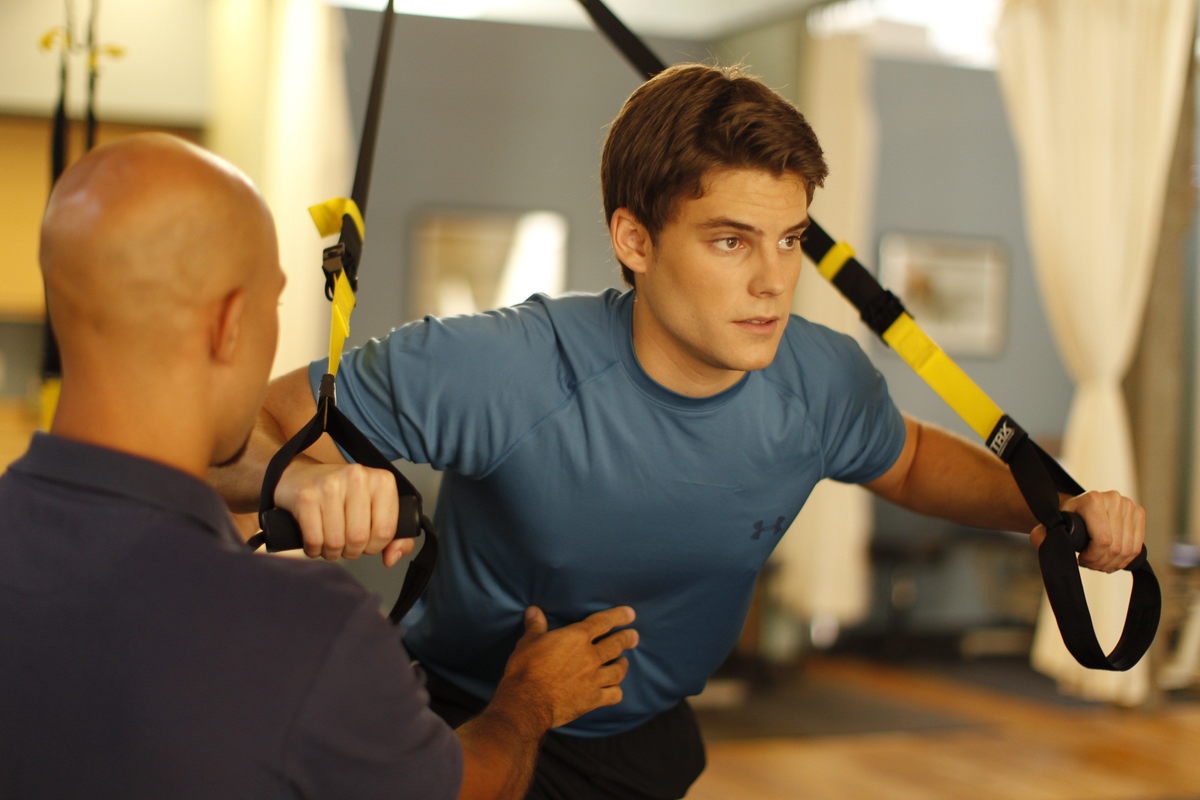The TRX squat, performed with a TRX Suspension Trainer for added support, is an effective exercise for building leg strength using body weight. It is especially beneficial for adolescents who are still developing but want to enhance their fitness levels. Additionally, TRX squats are ideal for individuals with balance or mobility challenges, as the handles provide constant support during the exercise.
How to Perform a TRX Squat
- Adjust the TRX Suspension Training straps to mid-length.
- Stand upright facing the anchor point with your feet shoulder-width apart. Hold the TRX handles with your palms facing each other and elbows in on your sides. Make sure you are far enough from the anchor point so there is no slack in your TRX straps while in this starting position.
- Engage your core and keep your chest up as you bend your knees and lower your hips back and down into a squat position. Make sure your knees track over your toes.
- As you lower into the squat, keep a firm grip on the TRX handles to help maintain balance. Your elbows will naturally extend to allow your body to lower down. Avoid hanging off the straps while at the bottom of your TRX squat.
- Push through your heels to return to a standing position, straightening your legs while maintaining tension on the TRX straps.
- Perform the desired number of repetitions, focusing on maintaining good form throughout each squat.
Proper Technique for TRX Squats
The TRX squat follows the same form and cues as the conventional squat. When executing the TRX squat:
- Ensure that your weight is evenly distributed across your feet, avoiding excessive leaning on your heels or toes.
- Keep your knees aligned with your ankles throughout the movement to maintain proper alignment and reduce stress on the joints.
- Maintain a neutral spine and pelvis position to protect your back and engage your core muscles effectively.
- Keep your shoulders pulled down and back to support proper posture and stability during the exercise.
Mastering the correct form for TRX squats is crucial for minimizing the risk of injury and ensuring you train the right movement pattern. A solid form in TRX squats not only protects you but also enhances your performance in other compound TRX exercises.
Benefits of the TRX Squat
The TRX squat offers numerous advantages that enhance the appeal of the TRX Suspension Training System. Among the key benefits are:
- It is a superb and straightforward way for people of all ages to train.
- It offers minimal risk, is easy to carry, and can be used in various ways.
- It is an excellent method for enhancing overall body strength and boosting muscular endurance.
- It allows you to perform a range of closed kinetic chain exercises, improving functional movement and muscle coordination.
- It requires that your core remains activated throughout the exercise.
- It is an excellent choice for a wide range of isolation and compound exercises, catering to various fitness goals and preferences.
- It makes unilateral movements such as pistols or single-leg squats more accessible to you, enhancing balance, stability, and muscle coordination.
- It safely allows you to explore and improve your range of motion during workouts, promoting flexibility and reducing the risk of injury.
- It enables greater control over body weight exercises and facilitates the execution of functional movements, contributing to improved overall fitness and movement efficiency.
Why Is the TRX Squat Good for You?
The TRX Suspension Trainer is an excellent aid for your squat and is particularly beneficial for beginners or those aiming to enhance their squat mechanics and technique. It offers a safe and adaptable way to exercise, making it ideal for individuals with limited flexibility or joint mobility. It is best to use the TRX Suspension Trainer for people during rehabilitation sessions to improve their range of motion, increase tissue capacity, and enhance joint mobility.
Other Lower Body Exercises
- Leg Extension: Leg extensions are a popular lower body exercise that targets the quadriceps. A leg extension machine limits your range of motion and offers you stability, allowing you to focus on muscle contractions rather than balance. However, this workout can strain the knees. To prevent knee strain, decrease the poundage of weights you use on the machine, slow down your motion, and take breaks between reps.
- Machine Leg Press: The machine leg press is a variation of the traditional leg press, focusing mainly on the quadriceps. It’s a compound movement that effectively builds strength and muscle mass in the quads. While the fundamental mechanics remain consistent, the use of a machine might alter your positioning slightly, depending on the specific equipment. This setup allows for a stable and controlled environment, ensuring you can concentrate on exerting force and maximizing muscle engagement. Additionally, it provides a safer option for those who might struggle with maintaining proper form during a free weight leg press.
- Leg Press: The leg press is a compound exercise that mainly targets the quadriceps much like the machine leg press. It resembles a standard squat but with notable differences. The most significant difference is the added support from the leg press machine, which stabilizes your back. This stability allows for a more controlled movement, placing greater emphasis on your quadriceps. The leg press is an excellent choice for those aiming to build muscle mass or increase strength in their quads. Additionally, the machine's support reduces the risk of injury by ensuring proper form and alignment during the exercise.
- Single Dumbbell Goblet Squat: The dumbbell goblet squat is a variation of the traditional front squat, primarily targeting the quadriceps like other squat exercises. In comparison to a barbell-weighted squat, this compound movement offers an advantage as it demands less upper-body mobility to maintain proper positioning. Also, holding a dumbbell close to the chest reduces strain on the shoulders and wrists, making it more accessible for those with limited flexibility. Goblet squats promote better posture and core stability, enhancing overall form and effectiveness.
- Single Dumbbell Sumo Squat: The single dumbbell sumo squat is a variation of the traditional squat, specifically resembling a sumo squat and goblet squat. This compound exercise primarily targets the quadriceps, similar to other squat variations, while holding a weight in front of your chest. The foot position is different in the single dumbbell sumo squat as the feet are wider than in a standard squat. The wider stance allows for a greater activation of the inner thighs and glutes than a regular squat, enhancing overall lower body strength and stability. The sumo squat position helps to accommodate mobility limitations, providing a more comfortable stance while still effectively engaging the muscles.
- Dumbbell Squat: The dumbbell squat is a variation of the traditional squat, primarily targeting the quadriceps like other squat exercises. Using two dumbbells in a suitcase hold or a racked position instead of a barbell, your range of motion is increased, making it a more accessible option for those with mobility limitations. This increased range of motion allows for a more personalized and comfortable workout. However, the added freedom also introduces a bit more instability, which can help improve your overall squat form and build the strength needed for heavier or more complex variations. Additionally, holding dumbbells engages the upper body and core, contributing to better balance and coordination.
- Air Squats: Air squats are a bodyweight version of squats, primarily targeting the quadriceps like other squat variations. Without added resistance, they are one of the most beginner-friendly exercises available. Air squats are an excellent way to start building strength and gradually progress toward more advanced squat variations. They also help improve flexibility, balance, and overall lower body endurance, making them a versatile addition to any fitness routine.
- Back Squat: The back squat is one of the three core powerlifting movements and a fundamental lower body exercise that uses a barbell across your upper back. This compound movement is excellent for building strength and muscle mass, particularly in the quadriceps. As a staple in most fitness programs, it is frequently used to gauge overall lower body strength. The back squat also engages the glutes, hamstrings, and core, making it a comprehensive exercise for enhancing lower body power and stability.
- Dumbbell Back Lunge: The dumbbell back lunge is a variation of the traditional lunge, primarily targeting the quadriceps like other lunge variations. The main difference is the addition of dumbbells (held in a suitcase position) which adds resistance and makes the exercise more challenging. This compound movement remains straightforward, allowing you to increase intensity without complicating the form. Holding dumbbells in each hand while stepping back into a lunge enhances muscle engagement in the quads, glutes, and hamstrings, providing a more effective workout for building lower body strength and stability.
- Dumbbell Front Lunge: The dumbbell front lunge is similar to the dumbbell back lunge except a step forward into the lunge is taken instead of a step back into the lunge. It also targets the quadriceps. Holding dumbbells (one in each hand in suitcase position) step forward into the lunge position. Push off the front foot to return to the starting position.



